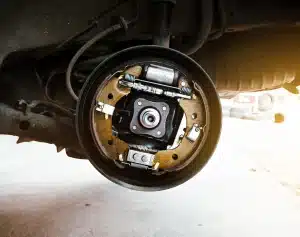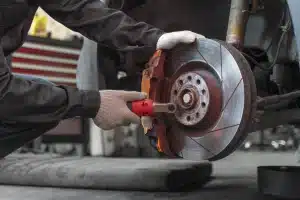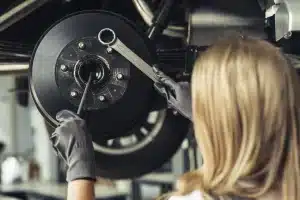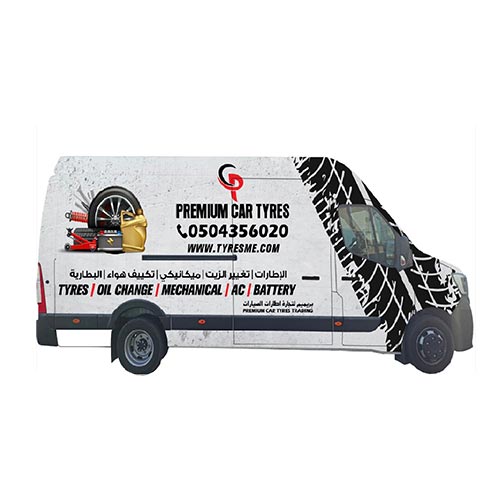Imagine you’re driving, laughing with your friends or family, enjoying the scenery zooming by. Everything feels perfect until you need to stop suddenly. That’s when the true heroes of your journey spring into action, hidden from view but always ready to keep you safe: your vehicle’s brake pads. This car brake pad guide highlights these essential components, which are like the guardians of the road, sitting quietly in your car’s wheels, waiting for the moment you press the brake pedal to do their job. According to our car brake pad guide, they’re often overlooked, but without them, stopping your car would be as difficult as trying to stop a soccer ball with nothing but air. Let’s dive deeper into what brake pads are and why they deserve more appreciation for keeping us safe every day, as our car brake pad guide suggests.
If you wish, you can use our services by referring to brake pad repair in Dubai. Also, by referring to car repairs in Dubai, you can find out about our various services.
What Are Brake Pads and Why Should You Care?
When you press the brake pedal, you’re not just sending a signal to your car to slow down; you’re initiating a sequence of events that leads to the magic of stopping a moving vehicle. It starts with your foot pressure, travels through a system filled with brake fluid, and ends up at the brake pads. But what exactly are these brake pads? Simply put, they are the parts of your car that, when pushed against the brake rotors, create friction to slow down and stop your car. They’re like the hands of a superhero, catching you safely every time you need to halt. Understanding this process is crucial because it helps you realize the importance of brake pads in your vehicle’s safety system. They’re not just pieces of your car; they’re your first line of defense against accidents. However, brake pad failure can significantly compromise this safety mechanism. Recognizing the signs of brake pad failure and addressing them promptly is essential for maintaining the effectiveness of your vehicle’s braking system. Ignoring the signs of brake pad failure can lead to reduced braking efficiency and, ultimately, increase the risk of accidents. Therefore, awareness and timely action regarding brake pad failure are vital for ensuring safe driving conditions.
We suggest you also read this article: how to choose the right tires for your car
The Key to Safe Stops: How Brake Pads Work
Now, let’s delve into the intricacies of brake pad functionality, a critical component of brake problems and solutions. Imagine you’re riding a bicycle and you squeeze the handlebars to stop. The mechanism that clamps the bike’s wheel is akin to how brake pads operate in a car. When you engage the brake pedal, a caliper—mirroring the clamp on a bike—presses the brake pads against the sides of the rotor (the metal disc attached to your wheel). This action generates friction, similar to the sensation of rubbing your hands together to generate heat. This friction effectively slows down the wheels and, as a result, your car. The remarkable aspect of brake pads, and a focal point in discussing brake problems and solutions, is their capacity to perform this task repeatedly, thousands of times, under a multitude of conditions, from the heat of summer to the chill of winter nights, ensuring the safety of you and your passengers. Recognizing the role of brake pads in this mechanism underscores their importance and underscores why their maintenance should be a paramount concern for every driver, highlighting a fundamental aspect of brake problems and solutions.
We also provide AC car repair services in Dubai.
The Vital Role of Brake Pads in Vehicle Safety
Have you ever wondered what happens in the split second after you press the brake pedal until your car comes to a complete stop? That moment when time seems to slow down is when your car’s brake pads become the unsung heroes of the road. These seemingly small parts of your vehicle play a monumental role in ensuring your safety every time you’re behind the wheel. Whether you’re stopping at a red light, slowing down for a pedestrian, or urgently halting to avoid a sudden obstacle, the brake pads are at the forefront of protecting you and your passengers. They’re the difference between a safe stop and a potential accident, making them one of the most critical safety features in your vehicle.
From Pedal to Metal: The Journey of a Brake Press
Let’s embark on the journey from the moment your foot presses the brake pedal to when your car comes to a halt. Pressing the pedal sets off a chain reaction that ends with the brake pads pressing against the rotors. This action is not merely a mechanical process but a carefully orchestrated dance of components working in harmony. The brake pads, made of durable materials, clamp down on the rotors, creating friction to slow the wheel’s rotation and, subsequently, the vehicle itself. This process may sound simple, but it’s a testament to engineering marvel. It allows vehicles, regardless of size, to stop within a reasonable distance, ensuring the safety of everyone on the road.
Why High-Quality Brake Pads Matter for Your Safety
The quality of brake pads directly influences the effectiveness of this stopping process. High-quality brake pads are designed to withstand high temperatures and pressures, ensuring consistent performance regardless of the driving conditions. They’re the foundation of a reliable braking system, offering peace of mind that your vehicle will stop when you need it to. Inferior brake pads, on the other hand, may wear out faster, reduce braking efficiency, and potentially put you at risk. Investing in high-quality brake pads means investing in your safety and the safety of others. They ensure that every journey, no matter how ordinary it may seem, ends as safely as it begins. So, when it comes to choosing brake pads, remember that you’re not just selecting a part for your car; you’re choosing the guardians of your road safety.
If your car needs oil change, you can go to oil change in Dubai.
A Closer Look at Brake Pads: Types and Their Uses
When it comes to selecting the right brake pads for your vehicle, it’s essential to understand the different types available and how they correspond to your driving needs and preferences. Here’s a breakdown of the main types of brake pads, each with its specific characteristics and ideal use cases:
- Semi-Metallic Brake Pads: The Heavy-Duty Performers
– Composition: These are comprised of a blend of metals such as steel, copper, and iron, making up about 30% to 65% of the pad’s material.
– Advantages: They excel in heat dissipation and provide excellent stopping power, especially under demanding driving conditions or for heavier vehicles.
– Drawbacks: Their robust nature means they can be louder during operation and may contribute to quicker wear on brake rotors compared to softer pad materials.
– Ideal for: Drivers who require high performance from their brakes, such as in heavy vehicles or when driving in demanding conditions where durability and high temperature tolerance are paramount.
- Ceramic Brake Pads: For the Love of Quiet and Clean Stops
– Composition: Crafted from a dense ceramic material mixed with copper fibers, these pads are designed for optimal performance.
– Advantages: They are known for their quiet operation and minimal brake dust production, keeping wheels cleaner and ensuring a smoother ride.
– Drawbacks: Ceramic brake pads generally come at a higher cost, but the investment pays off in terms of performance, noise reduction, and cleanliness.
– Ideal for: Everyday drivers looking for a balance between performance, durability, and a quiet, clean braking experience. They are well-suited for standard city and highway driving.
- Organic Brake Pads: The Eco-Friendly Choice
– Composition: Made from natural fibers like glass, rubber, and resin, these pads are softer and more eco-friendly.
– Advantages: Organic pads are known for their quiet operation and less aggressive wear on brake rotors, making them a gentle choice for daily driving.
– Drawbacks: They tend to wear out faster than metallic or ceramic options and might not perform as well under extreme conditions or in high temperatures.
– Ideal for: Drivers who prioritize environmental friendliness and a smooth, quiet ride, especially suitable for light to moderate driving conditions.
Understanding these distinctions helps in making an informed decision that aligns with your driving habits, vehicle type, and preferences, ensuring safety and optimal performance of your car’s braking system.
If your car battery has a problem, you can go to the battery replacement in Dubai.
Recognizing the Time for a Change: When to Replace Brake Pads
Just like how a tree’s leaves tell us when seasons are changing, your car has its way of letting you know it’s time for a change, specifically when it’s time to replace the brake pads. These vital components of your vehicle’s braking system don’t last forever. Over time, they wear down due to the friction created each time you stop your car. Knowing when to replace them is crucial for maintaining your vehicle’s safety and performance. Let’s dive into how you can recognize the tell-tale signs that your brake pads need changing, ensuring you stay safe on the road.
Listening for the Signs: Squeaks and Squeals
One of the most obvious indicators that your brake pads need attention comes directly from the brakes themselves. Have you ever pressed the brake pedal and heard a high-pitched squeak or squeal? This sound is not just a random noise; it’s a built-in alert system. Many brake pads have a small metal shim, known as an indicator, which is designed to make a screeching sound when the pad has worn down to a critical level. It’s like the brakes are saying, “Hey, pay attention to me!” This sound is your cue to schedule a brake pad check-up. Ignoring these auditory clues can lead to less effective braking and potentially unsafe driving conditions.
Visual Cues and Performance Checks: Staying Ahead of Wear
Aside from listening, there are visual signs and performance checks you can do to gauge the wear on your brake pads, a vital component of any car brake pad guide. One straightforward method, recommended by car brake pad guides, is to inspect the brake pads through the spokes of your car’s wheel. According to a reliable car brake pad guide, the pad should be at least 1/4 inch thick. If it appears thinner than that, it’s probably time for a replacement, a crucial tip often highlighted in car brake pad guides. Besides visual inspections, you might notice a change in your car’s braking performance. If it takes longer than usual to stop, or if the brake pedal feels “spongy” when pressed, these could be indicators, as noted in many car brake pad guides, that your brake pads are wearing out. Additionally, if your vehicle pulls to one side when braking, it could indicate uneven wear on the brake pads, requiring immediate attention, a scenario often addressed in comprehensive car brake pad guides.
Perhaps this article will also be useful for you: when to get an oil change
Selecting the Best Brake Pads: A Guide for Every Driver
Selecting the perfect brake pads for your car is crucial for ensuring optimal safety, performance, and longevity. Like choosing the right pair of shoes for different activities, picking brake pads requires considering how and where you drive. This guide provides detailed insights to help you make an informed decision, ensuring peace of mind on every journey, from daily commutes to adventurous road trips.
1. Matching Brake Pads to Your Driving Style
Understanding your driving habits is the first step toward selecting suitable brake pads. The choice heavily depends on your driving environment and the nature of your drives.
– City Driving: If you often find yourself in stop-and-go traffic, you’ll need brake pads designed for lower speeds and capable of handling frequent stops without wearing down quickly. These pads are formulated to provide consistent stopping power in urban driving conditions, where braking is more frequent but less intense.
– Highway Driving: For those who spend most of their time cruising on highways, brake pads engineered for high-speed deceleration with minimal wear are crucial. These pads are built to withstand the high temperatures generated by the faster stops, offering durability and reliability during long-distance travels.
– Adventurous Driving on Winding Roads: Driving enthusiasts who enjoy spirited drives on twisty roads should look for brake pads that resist fading under high temperatures. These pads maintain their efficiency and stopping power even under the stress of rapid deceleration from high speeds, ensuring safety and control on challenging terrains.
– Towing or Carrying Heavy Loads: Vehicles used for towing heavy loads require brake pads with a robust formulation capable of dealing with the extra weight. These pads offer enhanced stopping power and heat dissipation to prevent brake fade during intense use.
2. Considerations for Climate and Vehicle Compatibility
Beyond your driving style, it’s essential to consider the climate you drive in and your vehicle’s specific needs.
– Climate Considerations: If you live in an area with harsh winters or frequent rainy seasons, selecting brake pads that perform well in wet and cold conditions is non-negotiable. Look for pads that maintain grip and stopping power in adverse weather, ensuring your safety when the conditions turn challenging.
– Vehicle Compatibility: Ensuring that your brake pads are compatible with your vehicle is just as crucial as matching them to your driving style and climate. Not all brake pads are suitable for every car model. Using the wrong type can compromise braking performance and may even damage your vehicle’s braking system. Always refer to the manufacturer’s recommendations for your specific vehicle model to ensure that the brake pads fit correctly and enhance your car’s designed performance characteristics.
By taking these detailed considerations into account, you can choose the brake pads that best suit your vehicle’s needs and your driving habits. This careful selection process guarantees that you enjoy optimal performance from your braking system, ensuring safety and reliability on every drive.
You can use our site to buy tires online in Dubai.
Tyres Me: Your Go-To for Rapid Mobile Van Repairs Within Two Hours
At Tyres Me, we’re revolutionizing the way you think about vehicle maintenance with our cutting-edge mobile van service, promising professional repairs in two hours or less. Understanding that time is your most valuable asset, we dispatch our vans equipped with state-of-the-art tools and staffed by seasoned repairmen directly to your location. Whether you’re stranded on the roadside, stuck at your office, or just relaxing at home, our team is ready to spring into action, ensuring your vehicle receives the highest level of care without the wait. With Tyres Me, experience unparalleled convenience, efficiency, and expertise, all designed to get you safely back on the road with minimal disruption to your day. Choose us for your next repair, and discover the difference professionalism and promptness can make.
Ready to experience top-tier service and get your vehicle back in peak condition? Don’t wait any longer! Contact our experts today for a personalized consultation or to make a reservation. Our team is standing by, ready to provide you with the professional advice and service you deserve. Reach out now and take the first step towards hassle-free, reliable vehicle maintenance.
Suggested content: how to know which battery to buy for car
FAQ
What are brake pads and why are they important?
Brake pads are crucial components of your vehicle’s braking system that create friction against the brake rotors to slow down and stop your car when you press the brake pedal. They are your first line of defense against accidents, making them essential for safe driving. Their ability to perform under various conditions ensures your safety and that of your passengers, highlighting the importance of maintaining them properly.
Why is it necessary to invest in high-quality brake pads?
High-quality brake pads are designed to withstand high temperatures and pressures, providing consistent performance and ensuring your vehicle’s stopping effectiveness under various driving conditions. Investing in superior brake pads contributes significantly to road safety, offering peace of mind that your vehicle will stop as expected, every time.
What are the different types of brake pads available?
There are three main types of brake pads: Semi-Metallic, Ceramic, and Organic. Each type has its specific characteristics and ideal use cases, from heavy-duty performance and quiet, clean stops to eco-friendly choices. Understanding these differences can help you choose the right brake pads based on your driving needs and preferences.
How can I tell when it’s time to replace my brake pads?
Signs that it’s time to replace your brake pads include hearing a high-pitched squeak or squeal when braking, which indicates the pads have worn down to a critical level. Additionally, visual inspections through your car’s wheel spokes can show if the pad thickness is less than 1/4 inch, and changes in braking performance, such as longer stopping distances or a spongy brake pedal feel, also signal the need for replacement.
What factors should I consider when choosing brake pads for my vehicle?
When selecting brake pads, consider your driving style (city, highway, adventurous, or carrying heavy loads), the climate you drive in, and your vehicle’s specific needs. Ensure the brake pads are compatible with your vehicle model and suited to withstand the conditions you commonly face, such as wet and cold weather, to ensure optimal performance and safety.
Can the wrong type of brake pads damage my vehicle?
Using brake pads that are not compatible with your vehicle can compromise braking performance and potentially damage the braking system. It’s crucial to choose the right type of brake pads that match your car’s specifications and driving conditions to avoid these issues.
What advantages do ceramic brake pads offer?
Ceramic brake pads are known for their quiet operation and minimal brake dust production, making for a cleaner and smoother ride. While they may come at a higher cost, the investment pays off in performance, noise reduction, and reduced wear on your vehicle’s wheels.
How does Tyres Me mobile van service enhance vehicle maintenance?
Tyres Me mobile van service provides professional repairs within two hours or less, directly to your location, whether you’re at home, work, or stranded roadside. This service offers convenience, efficiency, and high-quality care, ensuring your vehicle receives prompt attention without the wait, revolutionizing how you think about vehicle maintenance.




